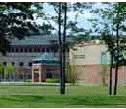|
JKR and Other Adhesion Models
DMT
For DMT Model, the approximate expression for the contact radius is given as
 |
(20) |
or
 |
(21) |
Variation of the nondimensional contact radius with the nondimensional force as
predicted by the DMT model is shown in Figure 2 and is compared with the JKR model.
Note that for  , Equation (21) and
Figure 2 shows that , Equation (21) and
Figure 2 shows that  . .
The corresponding resistance moment as a function of nondimensional force as predicted
by the DMT model is given as
 |
(22) |
The variation of the resistance moment as predicted by the DMT model is also shown in
Figure 3. The corresponding maximum resistance moment is
 |
(23) |
Note also that the maximum force (the poll-off force) is given by
 |
(24) |
and
 |
(25) |
Comparing Equations (17) and (23) shows that the JKR model predicts a larger resistance moment. That is
 ,
( ,
(  ) ) |
(26) |
The resistance moment predicted by the JKR and the DMT models in dimensional form are given as
 , ,
 |
(27) |
| 




























 , Equation (21) and
Figure 2 shows that
, Equation (21) and
Figure 2 shows that  .
.




 ,
(
,
(  )
) ,
,
